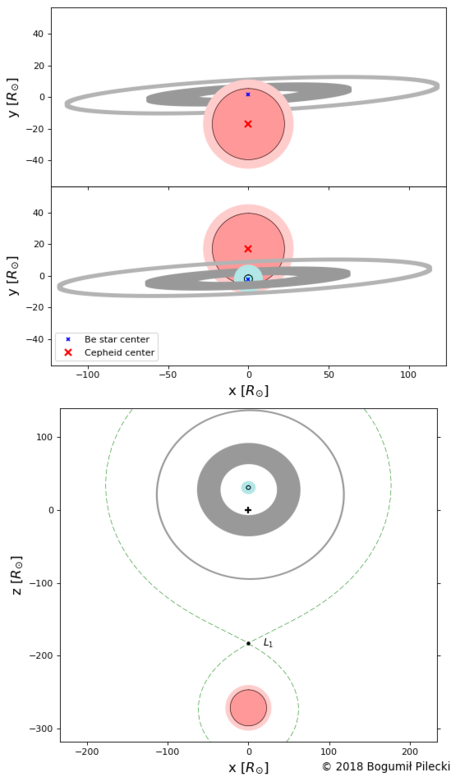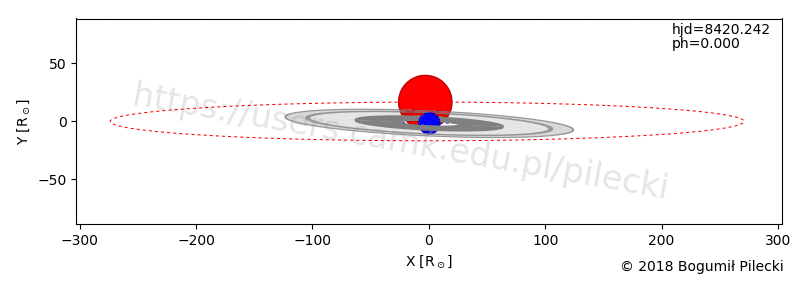 |
Catalogs
Cepheid Phys. Properties
Binary Cepheid Solutions
Projects
SB2 Cepheids
Classical Cepheids
Type II Cepheids
Papers
by category
by first author
by target
Visitors so far: 87697.

Relevant publication:
2018, ApJ, 868, 30 (← click to see the publication at ADS/arXiv)
Type II Cepheids are low-mass pulsating stars that belong to the disk and halo populations. They were also known before as Population II Cepheids and are a much older counterpart of the more massive classical Cepheids. Their periods and amplitudes are in a similar range, but type II Cepheids are about 1.5-2 mag fainter. They exhibit a tight and well-defined period-luminosity relation, and because of that may be also used to measure distances both inside and outside of our Galaxy. In spite of lower brightness as compared to classical Cepheids, they are important distance indicators because of their presence in old stellar systems, where classical Cepheids are not found.
Although all type II Cepheids obey a similar period-luminosity relation, they not form a homogeneous group, being usually divided into three subgroups depending on the pulsation period, observational properties, and evolutionary status. Those with the shortest periods are called BL Herculis stars, those with periods 4-20 days are called W Virginis stars, and those with longer periods — RV Tauri stars. This division is however based on old models that confirmed the existence of the three groups, but did not give much details on the stellar parameters or the occurrence frequency of each particular subtype. Moreover in some modern evolutionary models it is impossible to recreate this division.
In the last decade, another group that obey a similar period-luminosity relation and with periods in the same range as W Vir stars was discovered. These stars, however, have different light curve shapes. There is also a strong observational evidence that the majority, or even all of them, are members of binary systems. For some eclipses were also observed, and these particular systems are the most interesting to observe.
Dr Bogumił Pilecki from Nicolaus Copernicus Astronomical Center in Warsaw, Poland, together with his collaborators have performed spectroscopic observations and an analysis of one of such systems — OGLE-LMC-T2CEP-211. The first in history dynamical mass measured for a type II Cepheid (0.64 M⊙) resulted to be similar to the value expected for stars of this type. On the other hand, the very high mass of the companion star (5.67 M⊙) was quite surprising. Such a configuration was unambiguously pointing to the so-called "mass reversal" scenario. The analysis has shown, that in the beginning the system was composed of stars with masses of 3.5 M⊙ and 2.8 M⊙ and had an orbital period of about 12 days. During the evolution the more massive star transferred the most of its matter to its companion, leaving practically only a helium nucleus, and currently the hydrogen make up only 8% of its total mass. The star started to shrink, entered into the instability strip and started to pulsate. The orbital period of the system after the mass transfer has increased to the current 242 days.
The important conclusion from this analysis is, that the studied Cepheid, despite its low mass, resulted to be a young object — its age was estimated to about 200 million years. Such an age is typical for classical Cepheids and not for those of population II. The analysis of evolutionary and pulsation models suggests that the mechanism described above may be responsible for the existence of all Cepheids of this type.
The next surprise was the discovery of a circumstellar disk with a complex structure during the analysis. Around the companion to the Cepheid a presence of at least two (and most probably three) rings on wide orbits (around 60 and 120 R⊙, see the figure) was detected. An existence of these rings is not easy to explain, because the disk should not be currently fed with the matter of the Cepheid - the transfer has finished about 2.5 million years ago. Moreover there is an evidence that the companion to the Cepheid can be a fast-rotating Be-type star encompassed by a decretion disk of a smaller size (about 9 R⊙), which makes the whole structure of the system even more complicated.
There are at least three potential sources of the rings creation, of which any could have some influence on their current structure. 1. During the mass transfer surely an accretion disk was created. The remnants of this disk could survive for some reason until today even without being fed by the new matter. 2. Fast rotation of the companion may result in the creation of a decretion disk. Although it is dubious that the rings located far from the star could be formed this way, this phenomenon could extend the life of the accretion disk from the past mass transfer. 3. Although on much smaller scale, the Cepheid may still lose matter due to the stellar wind and high-amplitude pulsations (see the animation). This process is probably responsible for the creation of the most external outer rings.
The mechanisms of disk feeding are still a matter of debate and a detection and description of such a complex system brings a lot of data to study the involved processes.
The analysis of the presented system and its results were published in a renowned scientific journal: Astrophysical Journal, 2018, 868, 30, Pilecki et al., "The Dynamical Mass and Evolutionary Status of the Type II Cepheid in the Eclipsing Binary System OGLE-LMC-T2CEP-211 with a Double-ring Disk".
The project is supported by the Polish National Science Center (grant SONATA 2014/15/D/ST9/02248).
Contact: Dr. Bogumił Pilecki, pilecki@camk.edu.pl
 |
|---|
We present the analysis of a peculiar W Virginis (pWVir) type-II Cepheid, OGLE-LMC-T2CEP-211 (Ppuls=9.393d), in a double-lined binary system (Porb=242d), which shed light on virtually unknown evolutionary status and structure of pWVir stars.
The dynamical mass of the Cepheid (first ever for a type-II Cepheid) is 0.64 ± 0.02 M☉ and the radius R=25.1 ± 0.3 R☉. The companion is a massive (5.67 M☉) main-sequence star obscured by a disk. Such configuration suggests a mass transfer in the system history.
We found that originally the system (Porb,init=12d) was composed of 3.5 and 2.8 M☉ stars, with the current Cepheid being more massive. The system age is now ~200 My, and the Cepheid is almost completely stripped of hydrogen, with helium mass of ~92% of the total mass. It finished transferring the mass 2.5 My ago and is evolving towards lower temperatures passing through the instability strip.
Comparison with observations indicate a reasonable 2.7x10^-8 M☉/y mass loss from the Cepheid. The companion is most probably a Be main-sequence star with T=22000K and R=2.5 R☉. Our results yield a good agreement with a pulsation theory model for a hydrogen-deficient pulsator, confirming the described evolutionary scenario.
We detected a two-ring disk (Rdisk ~ 116 R☉) and a shell (Rshell ~ 9 R☉) around the companion, that is probably a combination of the matter from the past mass transfer, the mass being lost by the Cepheid due to wind and pulsations, and a decretion disk around a rapidly rotating secondary.
Our study together with observational properties of pWVir stars suggests that their majority are products of a similar binary evolution interaction.